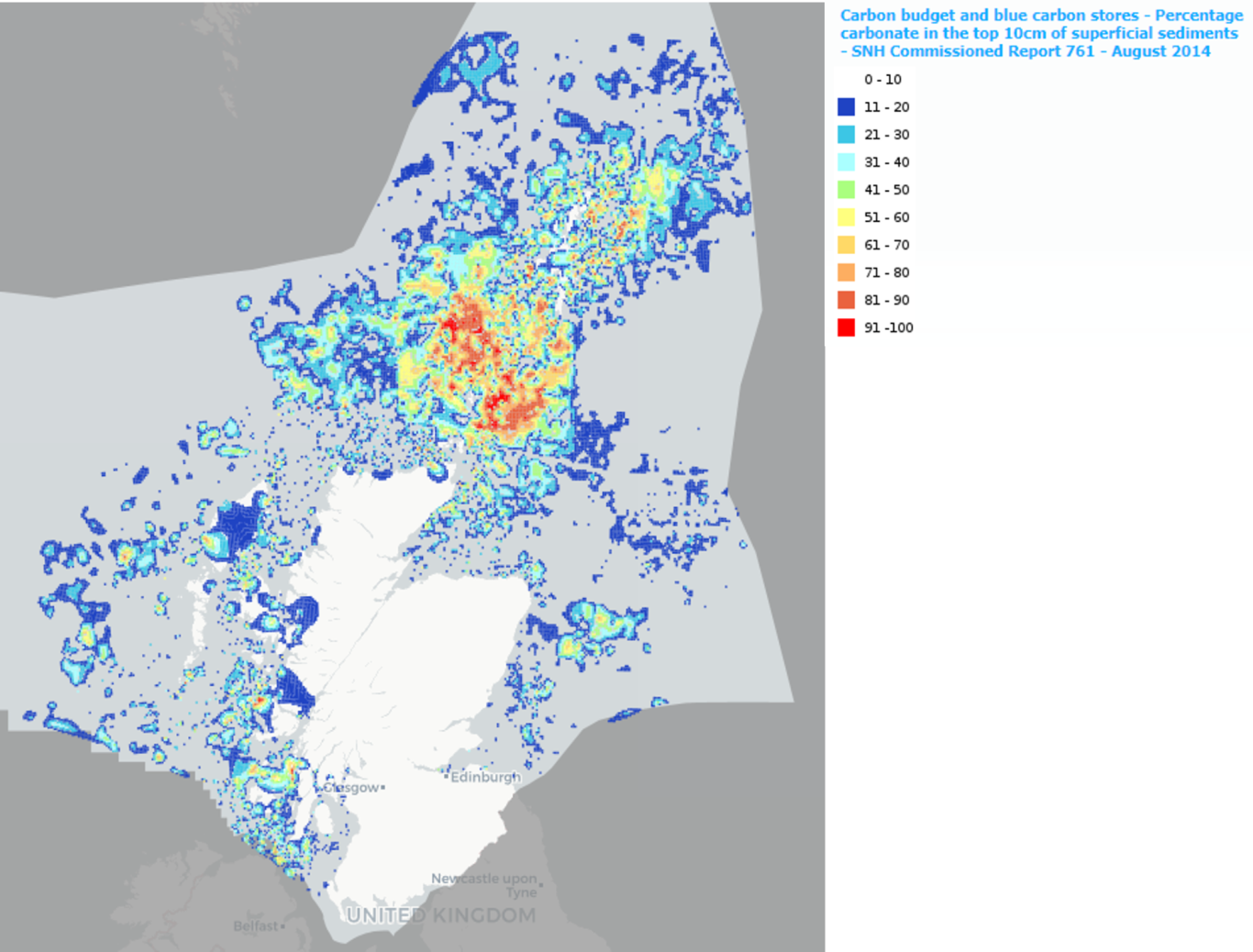www.stateofthecoast.scot
Blue Carbon in Scotland
Key Findings
With at least 152.3 million tonnes of organic carbon stored within Scotland’s marine environment (Burrows et al, 2024), blue carbon offers a powerful climate change mitigation strategy. Unfortunately, the country’s current blue carbon stores are in a highly degraded state (Scottish Wildlife Trust, 2016), with human actions responsible for the brunt of this damage (Shafiee, 2021).
Background:
Much like terrestrial carbon stores such as forests and peatbogs, the marine environment takes in and stores carbon. This carbon is referred to as ‘Blue Carbon’, stored in living creatures like kelp and seagrass, in non-living organic materials like shells, or directly dissolved into the water. (Scott & Lindsey, 2022).
There are multiple forms of blue carbon store, including marine sediment, saltmarsh, seagrass beds, kelp forests, maerl beds, and reefs of biological origin. Of these stores, kelp forests have the highest sequestration rate at 1,732,000 tonnes of carbon per year (Scottish Wildlife Trust, 2016), although they are a relatively short-term reservoir. The largest blue carbon store is found in sediments (both seafloor and loch beds sediments) storing 99.84% of the country’s total blue carbon (Shafiee, 2021).
Human impacts on these blue carbon stores are numerous. Direct interaction via trawling, fishing or construction work may damage marine plantlife and saltmarshes, while indirect climate affects such as increased storm severity and ocean acidification can erode shells and skeletons (Burrows et al, 2014). Should blue carbon stores continue to be degraded, the carbon released could compound the ongoing effects of climate change (Shafiee, 2021).
Current Situation:
The total volume of blue carbon stored in Scotland is the equivalent of 9,636 Megatonnes of CO2, a volume about 100 Megatonnes higher than that of terrestrial ecosystems (Shafiee, 2021). To put these values into context, in 2011 it was estimated that the carbon stored in sediments was enough to account for over half (52%) of the emissions from that year (Burrows et al, 2014).
Fig. 1 demonstrates the distribution of Scotland’s large near surface blue carbon store, with the highest concentrations found around Orkney and Shetland. Porter et al (2020) estimate Orkney’s waters to contain 67 Megatonnes of blue carbon. While these near surface stores are found around the country, the high concentration of blue carbon in sediments around Orkney is due to the area’s biological and geological diversity, allowing for the efficient capture and burial or organic carbon (Porter et al, 2020).
Fig. 2 demonstrates the distribution of three seagrass species around Scotland, found along most of the West Coast, with other clusters around Orkney, Shetland and the Moray Firth. Fig. 3 shows the estimated kelp habitat around Scotland in 2014, suggesting kelp is present around the majority the coastline, but is most concentrated around the Outer Hebrides. These areas should be the focus of ecosystem protection measures, as species like kelp and seagrass are highly important to the health of Scotland’s blue carbon stores.
Protection and Restoration:
Many blue carbon sequestration sites are currently protected by various nature conservation designations. Total blue carbon protected by such designations currently accounts for 50% of Scotland’s total organic carbon, and 37% of Scotland’s inorganic carbon, with the majority found in offshore MPAs and SACs (Burrows et al, 2024).
As of 2021 there was no clear government policy in place to restore blue carbon sequestration sites in Scotland (Shafiee, 2021). However, in 2018 a 5-year collaborative research project among various Scottish universities began, aiming to expand understanding of blue carbon sequestration in the country (Marine Scotland, n.d.).

Figure 1: % Carbon in the top 10cm of superficial sediments (NatureScot, 2014 b). Superficial refers to ‘young’ sediment deposits, laid down within the last 2.6 million years (British Geological Survey, 2024).

Figure 2: Distribution of seagrass species around Scotland (NatureScot, 2014 c)

Figure 3: Estimated kelp habitat over Scotland in 2014 (NatureScot, 2014 a)
Notes
None
Linked Information Sheets
Key sources of Information
British Geological Survey (2024) BGS Geology themes
Marine Scotland (n.d.) Blue Carbon, Topic Sheet Number 64
NatureScot (2014 c) Carbon budget and blue carbon stores - Seagrass records - NMPI Map
Porter et al (2020) Blue Carbon Audit of Orkney Water
Scott, M., & Lindsey, R. (2022) Understanding blue carbon
Scottish Wildlife Trust (2016) Blue Carbon Briefing
Shafiee, R. T. (2021) ‘Blue Carbon’, Scottish Parliament Research Briefing
Reviewed on/by
Status
Live - Next review due 06/03/2026
To report errors, highlight new data, or discuss alternative interpretations, please complete the form below and we will aim to respond to you within 28 days
Contact us
Telephone: 07971149117
E-mail: ian.hay@stateofthecoast.scot
We need your consent to load the translations
We use a third-party service to translate the website content that may collect data about your activity. Please review the details in the privacy policy and accept the service to view the translations.

